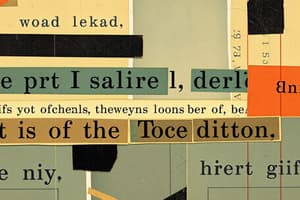Podcast
Questions and Answers
What is the primary function of exposition in a narrative structure?
What is the primary function of exposition in a narrative structure?
- To provide a climax to the story
- To resolve the story's loose ends
- To create conflict and tension
- To introduce the story, setting, and characters (correct)
What type of narrative structure presents events in a non-chronological order?
What type of narrative structure presents events in a non-chronological order?
- Non-Linear Narrative (correct)
- Linear Narrative
- Character-Driven Narrative
- Episodic Narrative
What is the term for objects, colors, or characters that represent abstract ideas or themes in a story?
What is the term for objects, colors, or characters that represent abstract ideas or themes in a story?
- Flashbacks
- Unreliable Narrators
- Foreshadowing
- Symbolism (correct)
What is the purpose of the climax in a narrative structure?
What is the purpose of the climax in a narrative structure?
What type of narrative focuses on the sequence of events and plot twists?
What type of narrative focuses on the sequence of events and plot twists?
What is the term for hints at future events or plot twists in a story?
What is the term for hints at future events or plot twists in a story?
Study Notes
Narrative Structure in Media Storytelling
Definition: Narrative structure refers to the organization of events, plot, and characters in a story to convey meaning and engage the audience.
Key Elements:
- Exposition: Introduction to the story, setting, and characters.
- Rising Action: Conflict and tension build-up, leading to a climax.
- Climax: The most intense and critical moment in the story.
- Falling Action: The aftermath of the climax, leading to resolution.
- Resolution: The conclusion of the story, tying up loose ends.
Types of Narrative Structures:
- Linear Narrative: Events unfold in chronological order.
- Non-Linear Narrative: Events are presented out of chronological order, often using flashbacks or flashforwards.
- Episodic Narrative: A series of loosely connected events or episodes.
Character-Driven vs. Plot-Driven Narratives:
- Character-Driven: Focus on character development and emotional arcs.
- Plot-Driven: Focus on the sequence of events and plot twists.
Storytelling Devices:
- Foreshadowing: Hints at future events or plot twists.
- Symbolism: Objects, colors, or characters representing abstract ideas or themes.
- Flashbacks: Scenes from the past that provide context or insight.
- Unreliable Narrators: Narrators who provide misleading or biased information.
Audience Engagement:
- Emotional Connection: Creating an emotional bond between the audience and characters.
- Suspense and Tension: Building anticipation and uncertainty to keep the audience engaged.
- Surprise and Twist: Unexpected events or revelations that challenge audience expectations.
Narrative Structure in Media Storytelling
- Narrative structure is the organization of events, plot, and characters to convey meaning and engage the audience.
Key Elements of Narrative Structure
- Exposition: Introduction to the story, setting, and characters.
- Rising Action: Conflict and tension build-up, leading to a climax.
- Climax: The most intense and critical moment in the story.
- Falling Action: The aftermath of the climax, leading to resolution.
- Resolution: The conclusion of the story, tying up loose ends.
Types of Narrative Structures
- Linear Narrative: Events unfold in chronological order.
- Non-Linear Narrative: Events are presented out of chronological order, often using flashbacks or flashforwards.
- Episodic Narrative: A series of loosely connected events or episodes.
Character-Driven vs. Plot-Driven Narratives
- Character-Driven Narrative: Focus on character development and emotional arcs.
- Plot-Driven Narrative: Focus on the sequence of events and plot twists.
Storytelling Devices
- Foreshadowing: Hints at future events or plot twists.
- Symbolism: Objects, colors, or characters representing abstract ideas or themes.
- Flashbacks: Scenes from the past that provide context or insight.
- Unreliable Narrators: Narrators who provide misleading or biased information.
Audience Engagement
- Emotional Connection: Creating an emotional bond between the audience and characters.
- Suspense and Tension: Building anticipation and uncertainty to keep the audience engaged.
- Surprise and Twist: Unexpected events or revelations that challenge audience expectations.
Studying That Suits You
Use AI to generate personalized quizzes and flashcards to suit your learning preferences.
Description
Test your knowledge of narrative structure, including exposition, rising action, climax, and falling action, in media storytelling. Learn how to engage audiences and convey meaning through story organization.




